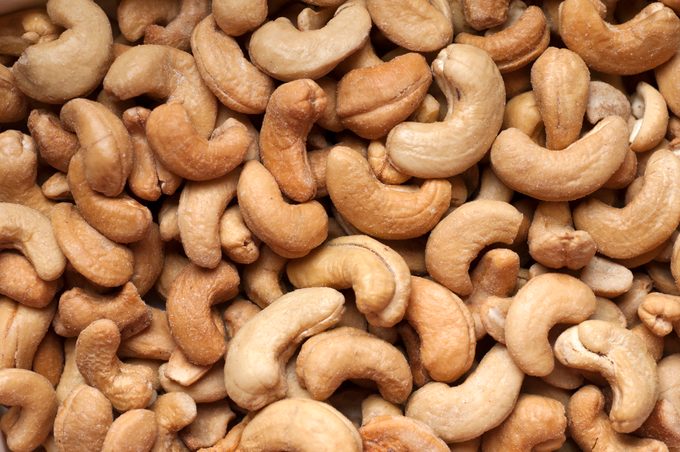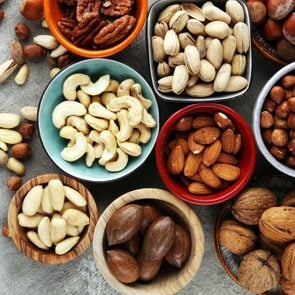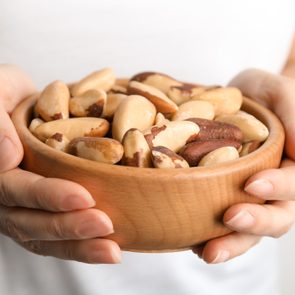Are Cashews Good for You? Here are the Nutrition Facts About Cashews
Updated: Mar. 16, 2022
These kidney-shaped nuts (or more correctly, seeds) are packed with nutrients and have heart-healthy benefits.
Our editors and experts handpick every product we feature. We may earn a commission from your purchases.
Crazy for cashews
Nuts about nuts? Then you won’t be surprised to discover that cashew consumption worldwide is way up. More than just a yummy snack, cashews’ softer consistency lends a dairy-free creaminess to sauces, smoothies, and even vegan cheese for those following a plant-based diet.
According to a 2019 report from the International Nut and Dried Fruit Council, world cashew production grew a whopping 32 percent over the prior 10-year average.
And that’s a good thing, because cashews are one of the 5 healthiest nuts you can eat.
How cashews are grown and harvested
But what are cashews exactly? To the surprise of many nut lovers, they’re not nuts. They’re actually “drupe seeds” that grow on the ends of a fleshy “false fruit” called a cashew apple. If you’re confused, you’re not alone: Pictures of the cashew apple and its seed caused the internet to “go nuts” just last year.
Once you see how cashews grow, you’ll never look at them the same way again. The apple can also be eaten. But it’s the kernel, or seed, inside the hard shell protruding off the end that’s the real prize.
Cashew trees grow in tropical climates and are native to Brazil. Portuguese explorers brought cashews to India and Africa in the 16th century. Eventually, they spread to other parts of Southeast Asia. Today, Vietnam is the world’s largest supplier of cashew imports, followed by India.
The process for getting them ready to eat, though, is labor intensive: They have to be harvested, separated from the apple, heated to make their shells easier to crack, then opened, often by hand. Because the shells are lined with a chemical that causes a skin reaction, cashews go through a steaming process to make them safe to eat, even if labeled “raw.” That’s why you don’t see cashews in the shell at the grocery store. Cashews usually have a cream color. Some, however, may be a bit darker (“scorched”) from the heating process.
Nutritional facts about cashews
Like nuts, cashews are rich in healthy fats, fiber, vitamins, and protein. But “cashews are slightly higher in saturated fat than nuts such as almonds, walnuts, and pistachios, while being just slightly lower in protein and fiber,” says New Jersey-based registered dietitian Erin Palinski-Wade, RD, author of 2 Day Diabetes Diet. And they “are rich in beneficial nutrients.”
Cashews also have a few additional minerals that are beneficial to health. “Cashews are rich in copper, which plays a role in the immune system, brain development, and energy production,” Palinski-Wade says. “Cashews are also a good source of magnesium and manganese, which play a role in bone health.”
Here’s the nutritional value per ounce (about 18 cashews), and their daily value, based on a 2,000 calorie diet:
Calories: 157 (8% DV)
Total fat: 12 g, including 2 g saturated fat (20% and 10% DV)
Dietary fiber: 0.9 g (3% DV)
Protein: 5 g (10% DV)
Carbohydrate: 9 g (3% DV)
Magnesium: 83 mg (20% DV)
Manganese: 0.47 mg (23% DV)
Copper: 0.62 mg (31% DV)
Iron: 2 mg (11% DV)
Zinc: 1.6 mg (11% DV)

Heart health benefits
Cashews have major benefits for heart health, likely because they are healthy high fat foods with mono- and polyunsaturated fats and omega-3 fatty acids.
“Diets rich in nuts have been linked with a reduced risk of heart disease,” Palinski-Wade says. This is in part because they lower cholesterol levels. “In people with type 2 diabetes, eating 10 percent of total calories from cashews daily was found to be associated with lower unhealthy LDL-cholesterol levels and higher (good) HDL cholesterol than in individuals who consumed no cashews.”
Specific research on cashews not sponsored by cashew producers is lacking. But a randomized trial in a 2017 issue of the American Journal of Clinical Nutrition found that cashews lower total cholesterol and LDL cholesterol.
In addition, “consuming cashews has also been associated with reduced blood pressure, which may be protective to the heart, and reduce stoke risk as well,” Palinski-Wade says.
Diabetes benefits
The American Diabetes Association calls nuts a “diabetes superfood” because of their nutritional qualities.
“Since cashews are rich in good fat and protein with little carbohydrate, replacing some carbohydrate in the diet with cashews may improve blood glucose control,” Palinski-Wade says. “Research has found a diet rich in cashews in individuals with type 2 diabetes has been associated with lower insulin levels, indicating it may offer benefits to blood glucose control.”
In addition, according to the Academy of Nutrition and Dietetics, many people with type 2 diabetes are low in magnesium, something cashews are rich in and which may help manage insulin levels as well. Cashews are one of the best diabetes foods to eat.
Weight management
Nuts are one of the best healthy snacks for weight loss. Although nuts do contain fats, they help you feel full longer and reduce noshing on less healthy options.
“Since cashews are rich in good fat, protein, and fiber, they digest slowly, helping to improve the feeling of satiety after eating,” Palinski-Wade says. “When used as a replacement for carbohydrate-based snacks in an equal calorie equivalent, you are more likely to feel satisfied from eating cashews, resulting in eating less at the next meal or snack, which may help to promote weight management.”
In one study, published in 2019 in BMJ Nutrition, Prevention and Health, increasing nut consumption by half a serving a day was associated with less weight gain and a lower risk of obesity. The authors concluded that replacing less healthy foods—like processed meat, potato chips, or desserts—with nuts may be a simple strategy for preventing weight gain. Keeping your weight in check is key to reducing your risk for other problems, like heart disease and diabetes.
Part of a healthy plant-based diet
Replacing meat with other nutrient-dense foods is also beneficial. “Adding plant-based fats and proteins to our diet should be a goal we all strive for to improve heart health, especially when used as a replacement for animal fats and proteins,” Palinski-Wade says. One study, published in a 2017 issue of JAMA, found that low nut consumption (fewer than five 1.5-ounce servings per week) was associated with 8 percent of deaths from heart disease, stroke, or diabetes.
Risks of consuming cashews
Obviously, stay away from cashews if you know if you have a tree nut allergy. For children or those who are just starting to eat nuts, keep an eye out for signs of allergy, including abdominal pain, difficulty swallowing, itching, or shortness of breath. Signs of a sudden, life-threatening reaction called anaphylaxis might also include trouble breathing, dizziness or fainting, hives, and rapid heartbeat. It can come on quickly, so call 911 right away and administer an epinephrine shot (EpiPen) if you have one.
If you happen to come across a cashew tree, don’t try to simply crack open the shell and eat the seed inside. The cashew tree is actually in a family of plants that includes poison ivy, poison oak, and poison sumac. The inside of the cashew shell contains the same toxic chemical compound, urushiol, that causes allergic skin reactions. But it’s fine to eat packaged cashews, of course, even if they’re labeled “raw.” That’s because they’ve been through a heating process that makes them safe to eat.
As with all nuts, be sure not to overindulge on cashews. “Just remember that cashews are energy rich, too, so keep an eye on the portions,” Palinski-Wade says. “They are nutritious, but overdoing can lead to an excess in overall calorie consumption, which can lead to weight gain.”
So how many should you eat? “For heart health, the American Heart Association recommends consuming four servings of unsalted nuts per week, with 1.5 ounces of whole nuts being one serving,” says Palinski-Wade. “So having cashews a few times a week in addition to a variety of other nuts may be the best choice when it comes to acquiring the nutrition and health benefits nuts offer.” An ounce is about 18 nuts. Cashews sold as “raw” are likely healthier than salted or roasted (particularly oil roasted).
Ethical cashew production
Remember that toxic chemical inside the cashew shell? Unfortunately, many workers in India and other countries working under poor conditions have suffered burns from the shells’ harmful compounds. If you want to make sure the cashews you’re buying have been harvested and shelled responsibly, research whether your brand of cashews is produced under fair trade, ethical practices (such as East Bali Cashews).
How to eat cashews
Cashews can be enjoyed plain as a snack, or added to meals: Asian dishes and curries in particular often use cashews. Or you can add them to everyday meals—even over your breakfast cereal. “Try adding cashews onto salads, on top of yogurt, into stir fries, and added into homemade trail mixes for a nutrient-rich, filling snack,” Palinski-Wade says. Cashews’ super-creamy texture is perfect in simple dairy-free recipes, like vegan sour cream, or for blending into smoothies and sauces.
Try registered dietitian Rachael Hartley’s quick and easy, no-bake recipe for Salty Cashew Coconut Energy Bars, made with rolled oats, cashews, dried apricots, shredded coconut, cashew butter, honey, and a bit of salt. Yum!





















